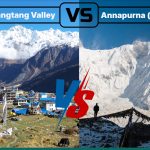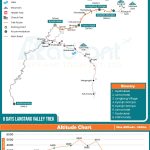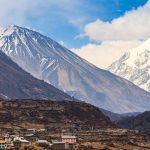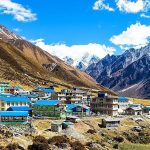Overview
Trekking through Nepal’s Langtang Valley in May feels like stepping into a living postcard. You can see the Himalayas unfold in layers of green valleys along with snow-dusted peaks. Similarly, the resilient villages welcome the trekkers with their unique culture and hospitality.
Located in Langtang National Park, this trek trail is just a day’s drive from Kathmandu. Furthermore, the Langtang Valley trek in May stands out for its raw beauty and accessibility. This is perfect for those who want Himalayan grandeur without the epic scale of the Everest Base Camp trek or the Annapurna Base Camp trek.
At around 70 to 80 kilometers total, with elevations peaking at over 5,000 meters on optional side hikes, it’s a moderate adventure. It rewards the trekkers with close-up views of giants like Langtang Lirung at 7,227 meters.

Meanwhile, May, which wraps up the spring season in Nepal, brings a special charm to the Langtang Valley. Forests are alive with rhododendron blooms in shades of pink and red. In addition, the crowds are milder after the April rush. Plus, the weather is mostly cooperative before the monsoon kicks in.
But the May Langtang Valley trek is not without some challenges. For instance, afternoon showers can turn paths slick. And the altitude demands respect. Whether you are a seasoned hiker or just starting high-altitude trekking, Langtang in May offers a balanced mix of challenge and wonder.

So, before you head out, plan for permits like the one needed for the national park entry, along with a budget with Radiant Treks, a trusted trekking agency in Nepal. It promises to take you to one of Nepal’s more affordable gems — the Langtang Valley in May.
Highlights
- May in Langtang means blooming trails and clear mountain mornings
- The crowds thin out after April and trekkers take quieter hikes
- Warm days and cool nights make trekking comfortable and scenic
- Rhododendrons and wildflowers light up the forests and meadows
- Buddha Jayanti in May adds cultural value to the May trek
- Afternoon showers refresh the Langtang Valley in May
Why Langtang Valley Trek in May

If you opt for the May trek of Langtang Valley, you are able to witness the essence of Nepal’s Himalayas at a transitional moment. That is because May is when spring is coming to an end. But this month is still bursting with life before the monsoon arrives. It’s a time when the trails feel more personal and the landscapes are more vibrant. On top of that, add the meaningful cultural encounters.
Whether you are drawn to the flowers, the views, or the people, May offers a balanced experience. Here are a few reasons that make this month stand out.
Fewer Crowds and Quieter Trails
In the May Langtang Valley trek, you are able to escape the height of spring’s rush. Specifically, March and April draw hordes of trekkers who are chasing the first rhododendron blooms. By contrast, by May, things have calmed down.
As a result, you find fewer groups competing for space at viewpoints or teahouses. Consequently, this allows for a more serene hike. It’s that time when you can hear the birdsong and river rush without the constant chatter of crowds. This quieter vibe lets you connect deeper with the surroundings. The trek turns into a reflective journey rather than a social event.
Floral Blooms and Scenic Beauty
May transforms Langtang Valley into a botanical spectacle. The forests come alive with rhododendrons in full bloom. As a result, you can see the slopes painted in hues of pink, red and white. Likewise, orchids cling to tree trunks and wildflowers are seen in the meadows. Meanwhile, the whole valley shakes off winter’s grip with an explosion of color. Additionally, add to that the fresh and rain-kissed earthiness in the air.
Favorable Weather
Weather-wise, May strikes a nice balance. Days are warmer than in early spring. Moreover, the mornings are clear and deliver sharp vistas of the Langtang range, Ganesh Himal and even hints of the Tibetan plateau on blue-sky days.
May trek means you are in the pre-monsoon phase in Langtang Valley. Therefore, you can dodge June’s heavy rains, though afternoon clouds or quick showers might roll in. Fortunately, they usually pass fast, often leaving the air even clearer. This weather condition makes for comfortable hiking. You need not face the chill of winter or the summer heat.
Cultural Features and Festivals
The timing aligns perfectly with cultural rhythms. Buddha Jayanti, the full-moon festival marking Buddha’s birth, enlightenment and death, usually falls in the beginning of May. During this time, in Kyanjin Gompa and other monasteries, there are gatherings and ceremonies.
The local festivals also offer a window into Tamang traditions. Likewise, May is also a time for planting crops, herding yaks and embracing spring’s energy.
Community Resilience and Economic Support
Langtang’s history adds a layer of meaning not only to the valley but to your journey as well. The Valley was hit hard by the 2015 earthquake. Now, the area has rebounded and the villages and teahouses rebuilt post-quake stand as testaments to local spirit.
Trekking here in May directly boosts the local economy. So, you can contribute to a community that has woven resilience into its daily life.
Accessible for Shorter Adventures
One of Langtang’s biggest perks is its proximity to Kathmandu. It is a rugged drive of 6 to 8 hours to Syabrubesi and you can start the trek without long flights or multi-day approaches. As a result, this makes it perfect for 8 to 10-day trips. And it is ideal if you are short on time but craving Himalayan immersion.
Likewise, the trails are accessible post-winter thaw. And there is no need for extreme logistics. Therefore, this lets you focus on the experience rather than the hassle.
Potential Challenges
You need to face some challenges during the Langtang Valley trek in May. There are a few things that demand careful consideration from the trekkers. For instance, lower humidity can invite leeches to damp spots. So, pack repellent and long pants. Warming temperatures call for versatile packing to handle everything from sunny days to cooler nights. Nevertheless, these are minor compared to the upsides — nothing a bit of preparation can’t handle.
All in all, if you want to be a part of a trek that’s intimate, scenic and culturally rich without the overwhelm, May in Langtang delivers just that.
Weather and Temperatures in May
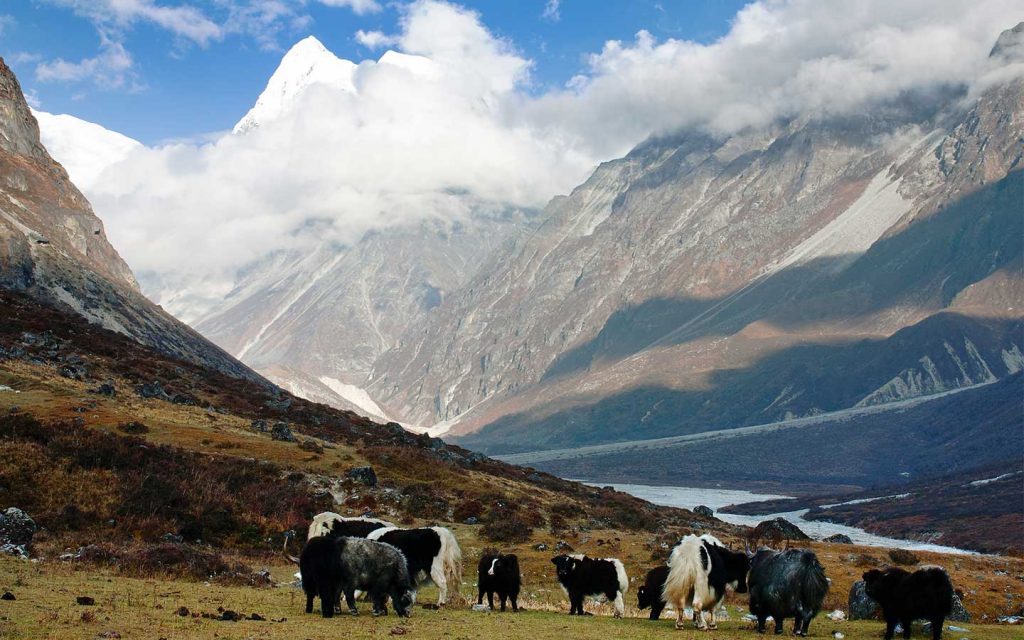
The weather patterns and temperatures in May vary sharply with altitude. As such, this can influence everything from what you pack to how you pace your days.
May brings warmer days compared to earlier spring months. But the arrival of this month also means a shift to the pre-monsoon period. Thus, expect a mix of sunshine and occasional moisture.
In the lower parts of the trail, from Syabrubesi at about 1,500 meters to Lama Hotel around 2,470 meters, daytime temperatures reach 15°C to 25°C. This makes for pleasant hiking in lighter clothes. Likewise, nights drop to 5°C to 10°C. Therefore, you can enjoy the evening fire wearing a cozy fleece jacket.
Climbing higher to Langtang Village at 3,430 meters and Kyanjin Gompa at 3,865 meters, the days are cool to 10°C to 15°C. And the nights hover between 0°C and to 5°C. Meanwhile, if you are pushing to side summits like Tsergo Ri at 5,033 meters, expect wind to make it chillier, potentially dipping below freezing at night.
Likewise, mornings in May tend to be clear and blue skies highlight the peaks and low haze for stunning photos. They are perfect for those early starts. Clouds tend to build during the afternoon and this can lead to short showers. Average rainfall is around 44 mm, usually in quick bursts rather than prolonged rain. This humidity keeps the valley green and vibrant. And it can slick up paths, especially on forested descents.
In addition, winter snow has largely thawed by May. It means there are only patches of snow in higher moraines. Moreover, fuller streams from the melt create scenic waterfalls and lively bridge crossings. Visibility in general is strong.
Langtang Valley Trek Route in May
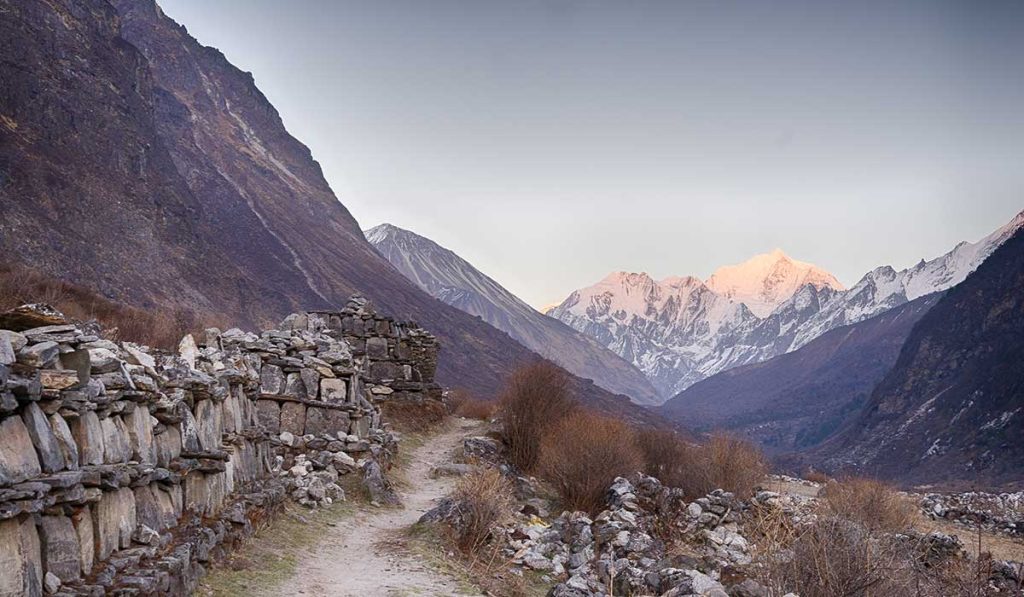
The trek trail of Langtang Valley features the spring season’s freshness in May. You can see snowmelt nourishing blooming meadows. And local communities are abuzz with planting and herding activities.
This journey of around 8 days spans roughly 70 to 80 kilometers round-trip. You may opt for a 10-day-long trek as well. There is about 3,500 meters of total elevation gain. And the trek displays themes of natural renewal, cultural resilience, along exploration of higher elevations. The terrain transforms from lush forests to alpine zones. And the moderate weather of May adds to the trek experience in this route.
Scenic Trek from Kathmandu to Syabrubesi
The Langtang Valley trek begins with a drive from Kathmandu to the trailhead at Syabrubesi. Along the way, this stretch features terraced farmlands and offers you glimpses of distant Himalayan foothills. It feels refreshing in May with greenery after winter and blooming roadside flora.
As there are fewer dust clouds, the ride via the bumpy road becomes more enjoyable in May. Upon arrival, in the Tamang gateway village of Syabrubesi, you will find basic facilities like shops and teahouses. Use the afternoon to acclimate. You can stroll to nearby hot springs to set the tone for the journey ahead.
Lower Valley Ascents
From Syabrubesi, the trail hugs the Bhote Koshi and Langtang Khola rivers, crossing thrilling suspension bridges that sway over roaring snowmelt waters. It is an adventurous journey after May’s occasional rains.
Covering about 11 kilometers with a 1,000-meter gain to Lama Hotel in 5 to 6 hours, the path winds through subtropical pine and oak woods. Furthermore, this part of the trail transforms into a floral spectacle in May. Rhododendrons explode in hues of pinks and reds. And the petals carpet the ground while langur monkeys chatter overhead.
Gradual stone steps and dirt tracks can turn slippery in May. Therefore, trekking poles help in such situations. So, carry one with you for safe navigation.
Park Entry and Climbs

Entering Langtang National Park after registration, the route ascends 10 kilometers with another 1,000-meter gain to Langtang Village in about 7 hours. Along the way, the path passes through Ghodatabela checkpost and opens into meadows. The greening yak pastures of May add a pastoral glow to the May trail. In addition, you can see herds of yaks dotting the landscape amid switchbacks that reward with Ganesh Himal vistas.
Here, themes of resilience shine in rebuilt Tamang settlements — stone houses adorned with prayer flags, where locals might offer tea and stories of recovery. Even so, the effects of altitude can be evident in May. So, pace slowly through these mixed forests and open fields during your trek.
Upper Valley Reaches
A gentler 9.7-kilometer hike with 500-meter gain in 5 to 6 hours leads to Kyanjin Gompa, where the valley broadens into alpine terrain past mani walls and chortens. In May, the meadows burst with colorful wildflowers, and the crisp mountain air welcomes you to the ancient monastery and yak cheese factory. Take the chance to taste fresh local produce while also exploring this peaceful basecamp. On clear days, majestic Langtang Lirung can be seen in the background, offering a serene backdrop.
Summit Side Adventures
Next, use time for acclimatization with side hikes like the steep round-trip to Tsergo Ri or the shorter Kyanjin Ri for sunrise views. These rocky journeys offer 360-degree vistas of snowy ranges, glaciers and the valley below. Fortunately, the milder winds of May and blooming plants ease the effort. Wind chill bites, but the rewards capture the trek’s majestic core.
Retracing Blooming Paths
The return journey retraces around 32 kilometers downhill over two days, from Kyanjin back through blooming valleys to Syabrubesi. This part is easier on the legs with gravity’s aid. Meanwhile, the humidity of May enlivens the forests and streams. Consequently, it makes bridges more exhilarating and descents a time for reflection on the landscapes’ shifts from alpine starkness to lush gorges.
The Journey Home
Wrap up with the 120-kilometer drive back, pondering the trek’s blend of adventure and seasonal splendor. For extensions, you can trek to Gosaikunda lakes as well and you need to add 2 to 3 days for that. In this journey, you can see for high tarns amid May’s flowers. Prioritize a guide and a porter for safety and cultural insights in this resilient region.
May Trek Difficulty and Preparation

If you want to conquer the Langtang Valley trek in May, you must be someone with decent fitness. That does not mean you can underestimate this journey. The trek is rated moderate, meaning it’s accessible for active beginners. Yet the May Lantang Valley trek packs enough punch to challenge you.
Expect 5 to 7 hours of daily hiking over about 70 to 80 km in total. Add to that with gradual ascents building to a base altitude of 3,865m at Kyanjin Gompa. And if you are up for optional side hikes, then you need to push to 5,000 meters, like Tsergo Ri. Steep switchbacks, uneven rocky paths and suspension bridges test your endurance.
And especially with pre-monsoon twists of May, the Langtang trek can be somewhat challenging. Warmer days with up to 18°C temperatures in lower elevations and 5°C to 12 °C at higher elevations make climbing more comfortable. But afternoon showers can turn trails slippery and muddy. And it also increases the chances of leech encounters in humid forests.
The altitude is the real kicker here — Acute Mountain Sickness (AMS) can sneak up with headaches or fatigue above 3,000 meters. So, pacing is key to preventing the sickness as much as possible.
To prepare for the trek, start training yourself 2 months before the trek. Try cardio exercises, including jogging and cycling along with swimming. Also, opt for strength training of your legs with squats, lunges and stair climbs.
For May specifics, train in wet conditions if possible. And pack rain gear, grippy boots, insect repellent and layers for cold nights that can dip to -5°C in higher altitudes.
In addition, learn about AMS signs, hydrate, carb-load, rest at Kyanjin for acclimatization and hire a guide for navigation and support.
Packing List

This packing list is based on what works for the Langtang Valley trek in May — think warmer days with blooming vibes, but sneaky afternoon showers, leeches in the lower bits and chilly nights up high.
Clothing
- 2 to 3 pairs of quick-dry trekking pants. Go for lightweight, zip-off ones that turn into shorts — perfect for May’s mild warmth, but durable for muddy trails.
- 4 to 5 moisture-wicking t-shirts or base layers. Get breathable synthetics or merino wool to handle sweat and long sleeves for sun protection.
- 1 to 2 sets of thermal underwears. Essential for cold nights above 3,000 meters as these areas feel nippy with wind in May.
- 1 fleece jacket or mid-layer. Cozy for evenings in teahouses; opt for something packable.
- 1 down jacket: Lightweight and compressible for high-altitude chills — rated to -5°C or better.
- Rain jacket and pants (waterproof/breathable). Gore-Tex style to fend off those pre-monsoon drizzles; a poncho works too if you are a minimalist.
- 5 to 7 underwear and socks: Quick-dry undies, wool hiking socks (with liners to prevent blisters), and extras for wet days.
- Hat and gloves. Wide-brim sun hat for UV rays, beanie and light gloves for cold mornings/nights.
- Buff or bandana. Versatile for neck sun protection, dust or as a headband.
Footwear
- Sturdy and waterproof trekking boots with good ankle support and grip, as May trails can be slippery from rain or snowmelt patches.
- Camp shoes or sandals for teahouse evenings and river crossings.
- Gaiters to keep out leeches and mud in humid lower forests.
Gear and Essentials
- 40 to 50L backpack with rain cover
- 4-season sleeping bag, comfort rated to 0°C or lower
- Adjustable trekking poles for stability on steep ups/downs and river crossings
- Headlamp or flashlight with extra batteries
- 2L water bottle or hydration bladder plus purification tablets or filter
- UV-protected sunglasses
- Sunscreen with SPF 50+ and lip balm
Health, Toiletries and First Aid
- Personal first-aid kit comprising band-aids, blister pads, painkillers, altitude meds, antidiarrheal and antiseptic
- Insect repellent for leeches in May’s damp lows
- Toiletries like biodegradable soap, toothbrush, toothpaste, wet wipes, hand sanitizer and toilet paper
- Any personal prescriptions
- Energy bars, nuts, dried fruits
Documents and Miscellaneous
- Passport, visa and permits
- Cash
- Travel insurance documents
- Phone, charger and power bank
- Plastic bags or dry sacks
- Notebook and pen
- Small camera, book or playing cards for downtime
Accommodation and Food in May

Teahouses are the heart of the Langtang experience for accommodation in May. With the spring crowds thinning, finding a room is easier in this month. Most are family-run, cozy places that reopen after winter. Typically, you will find simple wooden rooms with foam mattresses, shared bathrooms and warm dining halls where trekkers gather around the stove.
In lower villages like Syabrubesi or Lama Hotel, you might get solar-heated showers and electricity for charging. However, higher up at Kyanjin Gompa (3,800 m), amenities are basic. Expect cold bucket showers unless you pay for hot water, and power that may cut out early.
Meals are hearty and home-cooked. Of course, dal bhat — the classic rice, lentil soup and curry combo — keeps you going for hours. Meanwhile, momos, thukpa and local potatoes add variety.
May brings fresh greens and, if you are lucky, some berries in the lower hills. Don’t miss the yak cheese at Kyanjin. It is local, creamy and delicious. Breakfasts are simple — porridge, eggs, Tibetan bread and endless cups of tea keep you warm.
It’s basic living, but full of warmth and authenticity. Evenings often end with laughter and shared stories. And it is a perfect reflection of Langtang’s welcoming spirit.
Cultural Encounters in May
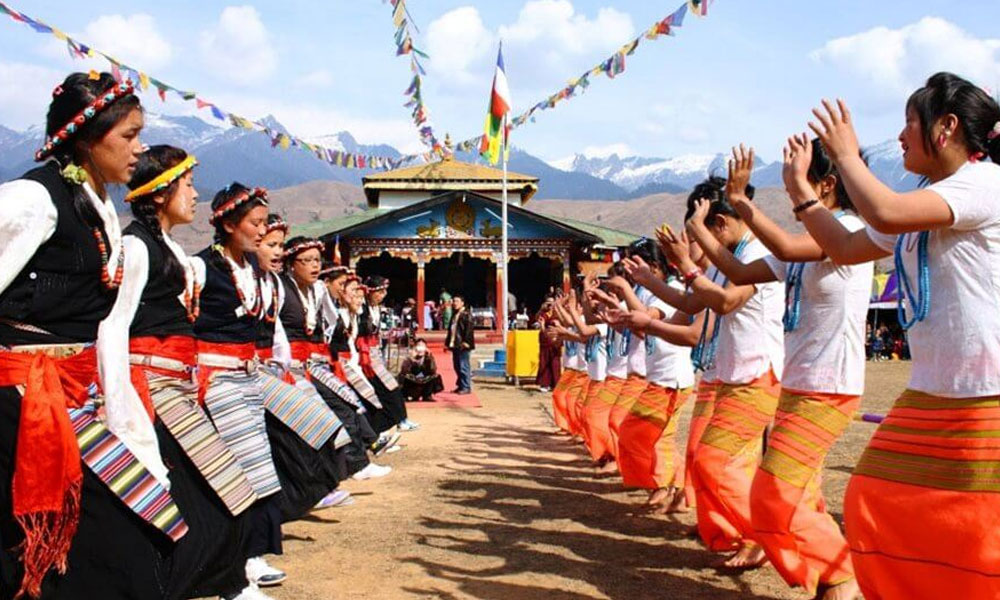
The Tamang and Tibetan-influenced communities along Langtang’s trails offer a window into mountain life. They are vivid in May when spring activities ramp up. These hardy folks, descendants of Tibetan migrants, greet with warm “Tashi Delek” and share homes rebuilt from the 2015 quake’s rubble. In May, you will see them planting barley or potatoes in terraced fields and herding yaks to fresh pastures. Or the locals can be seen spinning prayer wheels, a reflection of daily rhythms tied to the seasons.
Kyanjin Gompa stands as a cultural heart in Langtang Valley. And its monastery echoes with chants during Buddha Jayanti, which usually falls in May. Flags wave and butter lamps flicker during such celebrations in the monastery.
Interestingly, May highlights the valley’s renewal period. That means you can see blooms mirroring post-disaster rebuilding, blending Buddhist spirituality with resilient optimism.
Final Thoughts
Langtang Valley trek in May is an adventure, as well as it also offers quiet moments of reflection. It’s a journey where the Himalayas don’t just rise before you. Instead, it takes you through blooming trails and quiet cultural moments. But you also need to face the challenges of the May Langtang trek.
Afternoon showers can turn paths into muddy slides. And higher elevations may see winter’s snow patches. This demands a sure footing from trekkers. In lower elevations, humidity can turn favorable for leeches. So, you need to tuck pants into socks and dab on salt or repellent to keep them at bay.
Counter these by kicking off early to catch those crystal mornings, layering in Gore-Tex for sudden rains, and packing microspikes if you want to opt for side summits.
On the flip side, smart tips make it smoother: trekking poles steady you over roots and rocks, high-carb meals like dal bhat fuel the climbs, and rigorous acclimatization wards off altitude woes.
FAQS

Is the Langtang Valley trek in May suitable for beginners?
Absolutely! It is a great beginning if you want to understand Himalayan trekking. The trek is rated moderate with 5 to 7 hours of daily walking and gradual climbs up to 3,865 meters. Fit newbies can handle it with some cardio prep and altitude awareness, but steep bits and uneven paths mean it’s not a total walk in the park. Join a group if unsure.
How do you deal with rain?
May’s pre-monsoon showers are usually short afternoon bursts, so start hikes early to catch clear mornings. Pack a lightweight poncho or rain jacket. Trails drain fast in the porous soil, minimizing mud fests.
What’s the best way to book the May Langtang Valley trek?
Contact Radiant Treks for suitable packages. We handle the hassle via different packages that you buy.
What are the recommended side trips?
Hike to Tsergo Ri from Kyanjin for epic 360° panoramas of peaks and glaciers. For more, you can extend the trek to the sacred Gosaikunda lakes.


